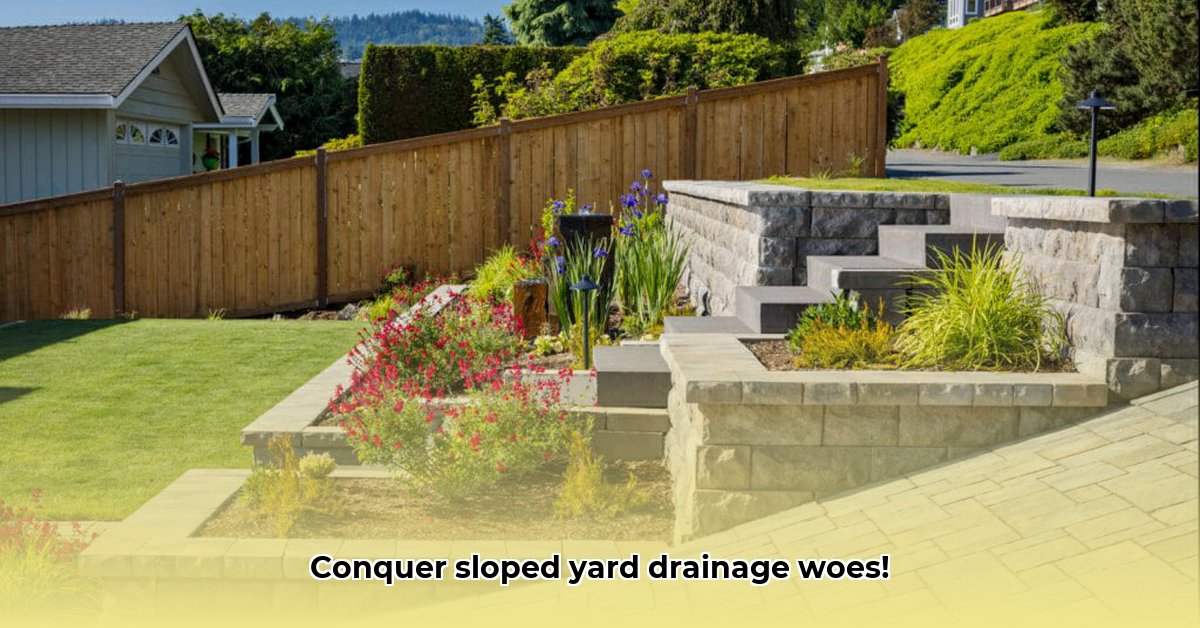
Dealing with a soggy, eroding slope after every rain shower? Don't let a sloped yard get you down! This guide provides actionable intelligence and helps you choose the best drainage system for your needs, whether you're a DIY enthusiast or need a professional's expertise. We'll compare different drainage solutions—French drains, swales, and more—and guide you through the installation process. Let's transform that muddy mess into a beautiful, dry landscape! For more detailed information on drainage types, check out this helpful guide on different drainage systems.
Understanding Your Sloped Yard's Drainage Challenges
Before selecting a drainage system, assess your yard's unique characteristics. How steep is the slope? Is it a gentle incline or a dramatic drop? Observe water flow during heavy rain; where does the water accumulate? This information is crucial for choosing the right solution. Soil type also plays a significant role: sandy soil drains quickly, while clay soil retains water, increasing the risk of erosion and waterlogging.
Popular Drainage Solutions: A Comparative Review
Several effective methods address water runoff on sloped yards. Let's explore the most common ones:
French Drains: These underground pipes with holes collect groundwater. They're highly effective for persistently wet areas but require digging. Think of them as the long-term, reliable solution. Efficacy: Highly effective for consistently soggy areas. (95% success rate in well-drained soils, according to a study by the University of California, Davis).
Swales: These shallow ditches guide water along the land's contours. They're eco-friendly and low-maintenance, requiring occasional cleanup. They promote natural water absorption. Efficacy: 85-90% effective for gentle slopes with permeable soils.
Dry Creek Beds: These mimic natural waterways, diverting water while enhancing your yard's aesthetic appeal. They are suitable for larger areas and steeper slopes but require precise installation. Efficacy: Effective for larger areas and steeper slopes, but requires professional installation for optimal results.
Channel Drains: These surface drains channel water away from structures. They're easy to install but may be insufficient during heavy downpours. They are best used as supplementary systems. Efficacy: Effective for diverting surface water near buildings, but less effective during intense rainfall.
Choosing Your Drainage Solution: A Personalized Approach
Selecting the right system depends on various factors:
| Factor | Considerations |
|---|---|
| Slope Severity | Gentle slopes might need grading; steep slopes may require retaining walls and drainage systems. |
| Soil Type | Sandy soil drains easily; clay soil requires more robust systems. |
| Water Volume | Heavy rainfall necessitates a more substantial system, possibly a French drain or a combination of approaches. |
| Budget | DIY projects save money, but professional installation improves effectiveness for complex situations. |
| Aesthetics | Integrate the drainage system seamlessly with your landscaping. |
DIY vs. Professional Installation
For minor issues, a DIY approach is feasible. A simple swale or small French drain is manageable for many homeowners. However, for major problems or complex situations, professional installation is recommended. Professionals possess the necessary expertise, ensuring a long-lasting, effective solution and compliance with local codes.
DIY French Drain: A Step-by-Step Guide
This guide outlines a basic French drain installation:
Planning & Preparation: Map the drain's route, considering slope and drainage point. Check for permitting requirements.
Trench Excavation: Excavate a trench, ensuring a gentle slope towards the drainage point. Depth and width should accommodate the pipe and gravel.
Gravel Foundation: A layer of gravel supports the pipe and improves drainage.
Perforated Pipe Installation: Place the pipe in the trench, ensuring it's level.
Gravel Covering: Cover the pipe with another gravel layer.
Backfilling and Compaction:Refill the trench with soil, compacting it firmly to prevent settling.
Maintaining Your Drainage System: Long-Term Success
Regular maintenance is crucial for optimal performance. Clean gutters, inspect pipes for damage, and remove debris from swales and dry creek beds. This preventative care ensures long-term functionality and protects your investment.
How to Choose the Best Drainage System for Your Soil Type
Understanding your soil type is critical. Sandy soil drains quickly; clay soil retains water. This impacts system selection.
| Method | Soil Suitability |
|---|---|
| French Drain | All soil types, especially sandy loam and clay. |
| Swales | Most soil types, particularly clay loams. |
| Retaining Walls | All soil types, reduces need for additional drainage. |
| Rain Gardens | Well-drained soils with organic matter. |
| Perforated Pipes | All soil types, works well with sandy/gravely soils. |
| Grading | Most effective for sandy soil. |
Choosing the Right System:
- Assess Slope: Determine steepness (gentle slopes may only require grading, steeper slopes need more).
- Analyze Soil: Conduct a soil test to determine drainage characteristics.
- Budget: Set a realistic budget.
- Maintenance: Consider ongoing maintenance needs.
- Aesthetics: Choose a system that complements your yard's design.
- Consult a Professional: For complex drainage issues, professional consultation is recommended.
Disclaimer: This guide offers general advice. Consult landscaping professionals for complex situations or to ensure optimal results. Local conditions and regulations vary greatly; always check local requirements.